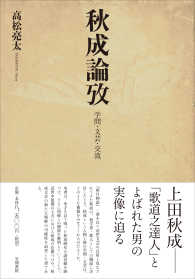- ホーム
- > 洋書
- > 英文書
- > History / World
Full Description
At the turn of the twentieth century, the city of Tianjin was the diplomatic capital of the Middle Kingdom, where foreign consuls met Chinese dignitaries, and a hub of commerce and culture. Yet in the eyes of foreigners, the city remained provincial. After the tumult of the Boxer Rebellion, however, Tianjin transformed, when a little-known international political project turned it for a time into one of the most cosmopolitan places in the world.
Pierre Singaravélou tells the story of Tianjin's emergence as a transnational metropolis, arguing that the city's experience challenges conventional narratives of the origins of globalization. He focuses on the aftermath of the Boxer Rebellion, when a number of imperial powers established an international military government that sought to modernize the city and its environs. Under its reign, people from all over the West and Asia flocked to Tianjin, in a whirlwind of commercial and cultural exchange. This provisional government embarked on ambitious public works and public health projects, attempting to transform not only the city's infrastructure but also its residents' behavior—all while the imperial powers seized large foreign concessions. Singaravélou traces the many tensions of the global city: between accommodation and resistance for Tianjin's residents, between colonization and internationalization within the provisional government, and between cooperation and competition among the imperial powers. Bringing together global and local perspectives, Tianjin Cosmopolis offers a new vantage point on the imperial globalization of the early twentieth century.
Contents
Introduction. Ten Empires on the Head of Pin: A Situated History of Imperial Globalization
1. "Pandemonium": The Siege, the Battle, and the Sacking
2. The Invention of an International Government: Foreign Military Bureaucracy or Chinese Democracy by Petition?
3. "Bringing Order to Chaos": Police Practices, Legal Repression, and Social Protection
4. Regional Planning: Foreign Appropriations and Local Contestations
5. A Revolution in Hygiene? Public Health, Environmental Protection, and Population Control
6. The Salt of the City: Statebuilding and the Emergence of Civil Society
7. The Urban Scramble: Dividing the City, Battling in the Streets
8. A Government for Posterity? Retrocession of the City and Administrative Continuities
Conclusion. "Straddling East and West at the Turn of the Century": A Contribution to the History of Modernity in 1900
Appendix. Archives Around the Globe: A Note on Sources
Translator's Note
Notes
Bibliography
Index






